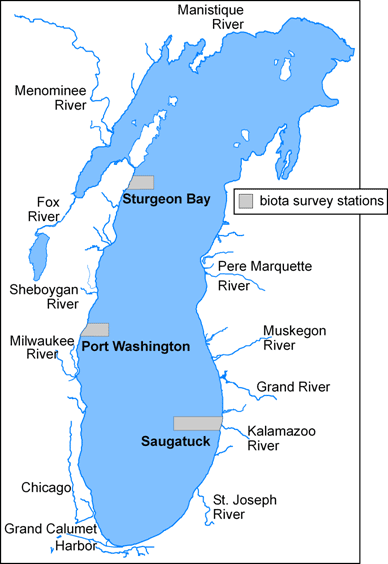Chemical Analyses
Summary

As part of the Lake Michigan Mass Balance Project, total and methyl mercury were determined for lake trout (Salvelinus namaycush) and five forage fish species collected from Lake Michigan near Saugatuck, Michigan, and Port Washington, Sheboygan Reef, and Sturgeon Bay, Wisconsin, between 1994 and 1995. With a mean concentration of 179 ng/g wet wt., whole lake trout total mercury (HgT) concentrations ranged between 27.6 and 348 ng/g wet wt. For combined sites, 1-4 yrs, 5-6 yrs, 7-11 yrs, and 12-15 yrs lake trout mean HgT concentrations were 73.3, 129, 212, and 280 ng/g, respectively. Forage fish species alewife (Alosa pseudoharengus), bloater (Coregonus hoyi), slimy sculpin (Cottus cognatus), deepwater sculpin (Myoxocephalus thompsoni), and rainbow smelt (Osmerus mordax) had mean HgT concentrations of 63.8, 55.3, 36.7, 51.4, and 35.2 ng/g wet wt., respectively. With the exception of alewife, bloater, and slimy sculpin, all fish species contained approximately 100% methyl mercury (MeHg). Field bioaccumulation factors (BAF) were consistent with a Lake Michigan food chain that is more efficient at transferring MeHg to higher trophic levels than some inland lakes. This and other studies of lake trout from Lake Michigan document decreasing HgT concentrations in lake trout from 1971 to 1985 and constant or increasing concentrations between 1985 and 2000. These observations were supported by a similar trend in Lake Michigan Hg sediment fluxes.
Publications
Raymond, B. and R. Rossmann. 2009. Total and Methyl Mercury Accumulation in 1994-1995 Lake Michigan Lake Trout and Forage Fish. J. Great Lakes Research, doi:10.1016/j.jglr.2009.05.004.
Reports
Rossmann, R. and J. C. Filkins. 2005. Standard Operating Procedure for Analysis of Tissue Samples for Methyl Mercury. LLRS-MET-SOP-021, Revision 3, Large Lakes Research Station, United States Environmental Protection Agency, 16 pp.
Parada, L., M. Levine, and R. Rossmann. 2002. Standard Operating Procedure for Analysis of Samples for Total Mercury using the Milestone Analyzer. LLRS-MET-SOP-022, Revision 1, Large Lakes Research Station, United States Environmental Protection Agency.
Rossmann, R. 2000. Standard Operating Procedure for Freeze-Drying Sediment and Biota Samples and Measuring Moisture Content. LLRS-MET-SOP-020, Revision 0, Large Lakes Research Station, United States Environmental Protection Agency.
Presentations
Raymond, B. T., R. Rossmann, J. C. Filkins, and L. Parada. 2005. Relative abundance of total and methyl mercury in 1994-5 Lake Michigan forage fish. 48th Conference on Great Lakes Research, International Association for Great Lakes Research, Ann Arbor, Michigan, May 23-27, 2005, p. 153 of abstracts.
Rossmann, R., J. C. Filkins, and M. Levine. 2003. Total and methyl mercury concentrations in 1994-5 Lake Michigan forage fish. Presented at 46th Conference on Great Lakes Research, International Association for Great Lakes Research, Chicago, Illinois, June 23-26, 2003, pp. 14-15 of abstracts.
![[logo] US EPA](../gif/logo_epaseal.gif)